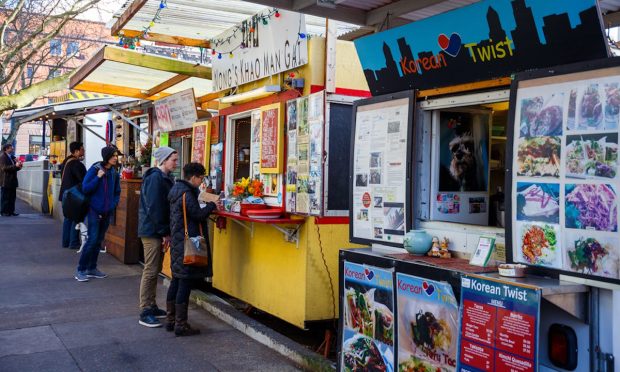Next-Gen Food Carts Gear up to Take Over City Streets

With the rise in off-premise digital ordering, restaurants and coffee shops are rethinking their formats. Brands are experimenting with ghost kitchens, robotic kiosks, physical locations that do not feature dining rooms, and other smaller-format models that fulfill consumers’ off-premise needs without the high costs associated with running a traditional restaurant. With these changes across the industry, mobile locations such as street carts are due for a resurgence, but prevailing street cart models cannot accommodate today’s consumers’ digital needs.
“Most street carts are powered by propane, which doesn’t really allow you to have enough power to run a proper, heavy-duty espresso machine and a point of sale system and accept online orders and everything you expect from a restaurant today,” Vinay Menda, co-founder of small-format specialty coffee company Blank Street, told PYMNTS in an interview. “Most street vending units are offline … our carts are essentially the same experience you’d have in a retail store, but in a cart.”
He added that with routers in its electronic carts, the coffee company is able to integrate with mobile loyalty programs to accept a range of payment types and to fulfill digital delivery orders. Blank Street recently raised $25 million in its Series A funding round, which the company intends to use in part to expand its digital capabilities, with mobile sales currently making up 20% of transactions.
There is certainly room to grow, according to PYMNTS data. Research from the Restaurant Readiness Index, created in collaboration with Paytronix, finds that for QSRs, digital orders currently account for an average of 47% of all transactions — and even for restaurants with table service, they make up 32%.
Read more: QSRs’ Lagging Loyalty-Reward Investment Hurts Innovation and Sales
Cart Contagion
These cart locations are created in partnership with EV Foods, a company that creates battery-run carts like Blank Street’s, as well as larger-format electric trucks. Menda predicts that by powering street carts with electric vehicle (EV) technology, it will become possible for more street carts to emerge, taking advantage of the relative simplicity of operating a battery-powered vehicle compared to dealing with a propane-powered one.
“It should make the lives of these vendors easier and allow for more vendors to be on the streets,” he predicted.
Additionally, he argued that the street cart model is an enduring one, noting that throughout their history, they have served an important function: allowing recent immigrants and others tasked with starting a business from scratch to make an income without the high real estate costs typically associated with opening a restaurant.
For now, the technology powering Blank Street’s carts is still prohibitive for most small business owners looking to get a cart up and running, but Menda stated that the price has already fallen by half in the past three to four years.
“I’m just really excited for the cost of battery technology to keep going down,” he said. “If the cost of our battery cart ends up being the same cost as the propane cart, every vendor is going to want to use that.”
Many Technologies Make Light Work
In today’s challenging labor market, with most restaurants struggling to pay workers competitive enough wages to keep stores fully staffed, Blank Street’s carts and other small-format models help the chain lower costs and more efficiently take orders, while also allowing the chain to offer low enough prices to attract consumers.
“You see similar models to our business across Asia, where the whole concept is to optimize the size of real estate and to use technology to enhance the ordering experience to lower the price of goods,” he said, adding that the mobile order-ahead option “optimizes the number of people you need in the store.”
For now, according to the Restaurant Readiness Index, mobile order-ahead purchases such as these still make up a fairly small portion of QSRs’ total business (only 17%). Still, the Index notes that restaurants that offer the ability to order using a mobile app consistently outperform those that do not, with 92% of top performers accepting mobile orders compared to just 31% of bottom performers.
Pickup Picks Up
While these pickup orders may now represent only a small portion of total orders, Menda believes that this figure will grow, with the channel gaining share from delivery. “I think delivery has been a good and bad thing for the restaurant industry,” he noted.
Menda argued that for all the benefits that delivery provides, attracting customers who would be unwilling to make the trip to the store, the cost of the model for restaurants makes it difficult to sustain long-term, while consumers are strained under the fees that the channel levies. Additionally, he noted that the percentage of pickup orders has been on the rise, even for aggregators such as DoorDash that built up their following on the strength of their delivery businesses.
“I think there’s going to be a renaissance in the pickup model,” he said. “That’s kind of what you saw happening in Asia, where mobile penetration is very high. I think people are willing to take the extra step to walk to a location to pick up an item, because they know it’s better for the restaurant … also, it’s a lot cheaper than delivery … pickup is the next frontier.”
